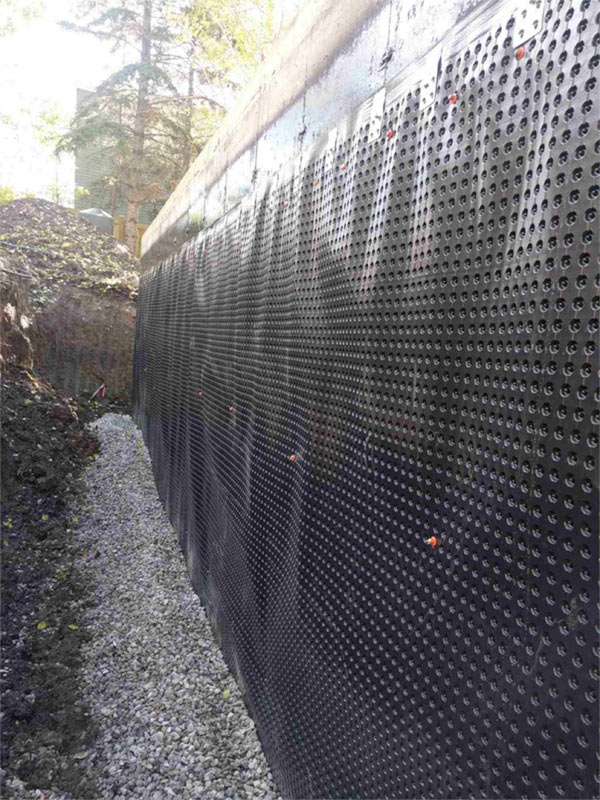
What you should know about foundation waterproofing?
Foundation waterproofing on a new home is usually unseen, often not understood, and really shouldn’t be an issue that concerns the buyer. It often is a concern, however, especially in the Edmonton region and the western suburbs such as Spruce Grove and Stony Plain. This is because rapid growth is making good development land expensive, and as costs climb, developers are choosing to work with lower, wetter, ground that might not have been considered in a different economic environment.
Building in low or seasonally saturated areas increases the costs of building the home, but not significantly when compared with the savings. The good news is that homes are being built at attractive prices, and the technology is available to make these homes just as safe and durable against flooding as any other home. Without a properly designed and executed design, however, the stakes are much higher. As a consumer or as a builder, it is vital that you understand what the options are, how and when they should be applied, and how to tell that waterproofing was properly done.
New home builders in Alberta commonly use one of three different approaches: spray dampproofing, drainage board, and self adhering membranes. Each one has a unique purpose, and the most expensive product is not always the best solution. The best solution requires evaluation of both seasonal moisture levels and soil drainage capacity.
Seasonal Moisture: Waterproofing vs. damp proofing
These terms are frequently used interchangeably, but have distinct meanings. Concrete is porous and has a very high capacity to hold moisture, so most building codes require a basic solution to slow down the transfer of moisture from the soil and air outside the house, to the concrete wall, and eventually into the basement.
Spray damp-proofing accomplishes this basic goal by drastically reducing the porosity of the outside wall surface. During intermittent rainstorms, when the ground actually gets wet, less water will be absorbed into the wall, and the wall can then dry out during warm dry weather. Damp proofing is acceptable in any condition where the available drying seasons are sufficient to completely remove all the moisture absorbed by the walls during the saturation season. Damp proofing is usually achieved using an asphalt based treatment that is sprayed, rolled or troweled on the walls below grade.
For climates or soil conditions that are more often wet than dry, waterproofing may be required. While damp proofing slows the transfer of moisture, waterproofing stops the transfer of moisture. This is necessary when the available drying time is not long enough to remove all the moisture the wall might absorb during the saturation time. In some climates, this moisture can come from humid air conditions as well as from the soil. Waterproofing is available through numerous different products, both liquid and membrane form. The advantage of membrane waterproofing is that it spans and seals all physical defects in the concrete—even if the wall cracks, your waterproofing stays intact.
Here in Alberta, we typically have a much longer dry season than wet season, because our cold season stays well below freezing for extended periods of time and because our warm seasons tend to be sunny and dry. As a result, we don’t usually need to deal with humid air conditions, just damp or wet soil, and spray damp-proofing is generally adequate to keep the concrete wall dry. The notable exception would be locations where the water table frequently rises to the footing height or above.
Soil Drainage
The second factor to consider is drainage capacity—how fast does moisture move away from your vulnerable foundation walls? Ground moisture comes from above, in the form of snow and rain, and from below, in the form of ground water. With enough water and time, even the best waterproofing system will fail, so taking steps to move more water in less time gives your waterproofing system the best chance of success and the longest worry-free lifespan.
By far the best solution available right now is one of the many engineered drainage boards available. While they all differ somewhat, they have the same basic function, which is to create a layer right beside the wall that never fills up or seals due to compaction, sluffing, etc. This layer allows all moisture to flow freely down to your weeping tile where it is carried away to the sump or to a dry well.
Before drainage boards became widely available, it was common for builders to truck in several loads of coarse sand or even washed rock, to be placed into the foundation trench against the wall along with the backfill soil, creating a porous layer that accomplished the same purpose as a drainage board. This approach is effective, but expensive, involving trucking heavy materials from off site, additional time for expensive heavy equipment, etc.
We strongly recommend that dimple membrane or drainage board such as Delta MS be used in conjunction with a damp proofing or a waterproofing solution, not by itself. As described, it is an engineered drainage layer designed to prevent buildup of hydraulic pressure against the wall in poorly drained soil such as clay. However, it does not reduce the absorption rate of the concrete wall at all, meaning that water vapour from the atmosphere and the ground can still be drawn into the concrete.
To summarise, your builder needs to make two separate decisions about protecting your foundation walls from moisture buildup. These two solutions need to complement each other. The complete foundation drainage system has numerous other components that must all work in conjunction with your wall treatment to move water away, and prevent it from coming back. We will address these other components in the next article—Ground Water and Basement Flooding.